�
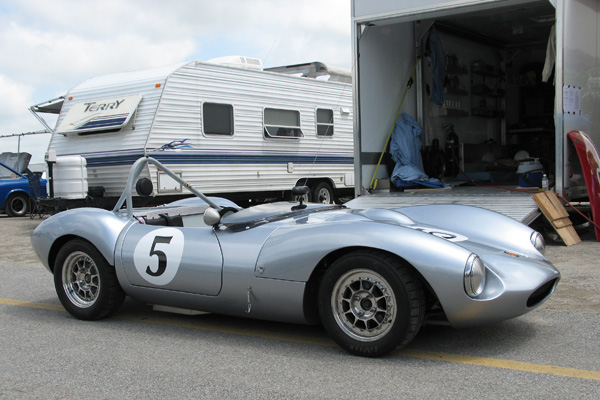
�
Craig Chima's Ginetta G4 Series Two Racecar
� Owner: Craig Chima� � City: Akron, OH
� Model: 1964 Ginetta G4
� Engine: Ford Cortina 1498cc
� Race prepared by: Craig Chima at CC Motorsports�
�
Ginetta G4 Background Information
��
In about 1957, Ivor Walklett decided to build a sports car and he recruited his brother �
Trevers to help. Their original one-off special was built largely from Wolseley Hornet �
components. Shortly after completion, it was destroyed in an accident in the family driveway. �
Undiscouraged, the two brothers decided to build a replacement. Their second design featured �
a tubular chassis and a Ford "8" engine. In response to requests from friends, the two brothers �
decided to duplicate the car and sell it in kit form. Once sales of G2 kits started, �
brothers Bob and Douglas joined Ivor and Trevers. Together, the four brothers founded �
Ginetta Cars Limited in 1958. Approximately thirty Ginetta G2 kits were sold. Another model, �
was introduced in 1959. The G3 featured a fully-fendered fiberglass body. Approximately �
sixty G3 bodyshells were sold. �
�
The Ginetta G4 model was unveiled at The British Racing and Sports Car Club's "Racing Car Show"�
at Earl's Court in London, in January 1961. Although the G4 was initially planned to utilize a �
proposed but never commercially available Coventry Climax 750cc engine, Ginetta was quick to �
recognize the qualities of the newest Ford engines: large bore, short stroke, lightweight �
crankshaft, and an overhead valve cylinder head with eight individual ports. The Ginetta G4 �
was no larger or heavier than it needed to be to fit the Ford ("105e" 997cc) engine. In the �
market and at the racetrack, the Ginetta would be competing with Elva and Turner models which were �
somewhat larger and heavier, and with the Lotus Seven which had a more old-fashioned appearance. �
Trevers has been quoted as saying that the Lotus Eleven racecar inspired the design of the G4. �
Indeed, as originally introduced the G4 body had rounded tailfins which bear some resemblence �
to the Eleven's. However, the G4 was marketed as a dual purpose "road and track" car. �
�
�
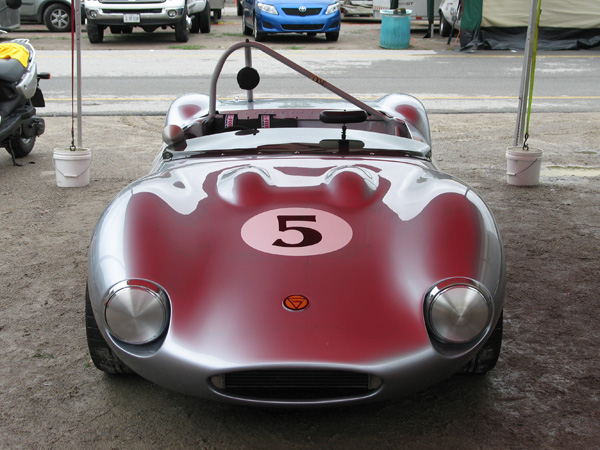
�
The Ginetta G4 offered an exciting alternative to the kit cars that proceeded it. The Lotus Seven
�
had been the top of the class. Obviously, the Ginetta is much more streamlined and modern looking.
�
Buyers gave up nothing in performance or quality, and the G4 was attractively priced too.
�
�
The Ginetta G4 featured a spaceframe constructed of 1" x 18-gauge round steel tubing, and an all�
fiberglass body. The center section of the fiberglass body was bonded onto the frame for �
added stiffness. Fitting of doors, front clip, and rear clip were left to the customer. The whole �
front of the car hinged forward much in keeping with the style set by the Lotus Eleven or �
Lola Mark One. The rear clip didn't hinge, but it was designed for quick detachment. It had a �
boot lid too for even easier access to cargo space, although Ginetta didn't provide a floor to �
the boot area. The customer could fabricate their own, or could leave it open for lightness and �
for suspension and fuel tank serviceability.�
�
The Ginetta G4 design changed substantially over time. As mentioned above, the early Series One �
bodies had small tailfins; but these were eliminated when the Series Two model was introduced �
in 1963. The Series Two rear bodywork was instead stretched out approximately eight inches to �
provide more cargo area. The Series 2 version also had re-located front spring mounting points �
and a BMC rear axle in lieu of the original Ford Anglia axle. The BMC axle was preferred �
because a better variety of gear ratios were available for it, because it weighed forty pounds �
less, and because it was two inches wider. The axle was located by trailing arms above and an �
A-bracket below. Independent rear suspension and four wheel disc brakes would soon be available �
in the G4R ("R" for racing) model variant that Ginetta introduced in 1964. In 1964 Ginetta �
also introduced a coupe version.�
�
The G4 Series Three of 1966 marked a real departure in design. The original round-tube frame �
was replaced with a new "square-tube" design, and the front suspension was redesigned to �
utilize Triumph Herald wishbones. From the outside, the Series Three could be differentiated �
easily because it sported pop-up headlights and a front bumper.�
�
How was the G4 rated by the press? When introduced at the 1961 Racing Car Show, it was �
voted the most beautiful car at the show. That seems to have set the tone for press coverage. �
After commenting on its beauty, press reports generally noted the car was only suited for true �
enthusiasts, but they praised its performance. For example, for their July 1964 edition �
"Practical Motorist" magazine commissioned 1963 Grand Prix champion Graham Hill to review the �
new Ginetta G4 GT. He wrote: "From the appearance point of view, the Ginetta is one of the �
prettiest small cars I've seen. Normally it is difficult to make a small car with the right �
proportions, but this one looks good... Summing up, I would say that this is an enthusiast's �
car, and at £650 in kit form good value for the money - I can't think of a cheaper G.T. car. �
It has a lively engine, above average road holding, good brakes and steering, and should give �
a keen driver a lot of enjoyment."�
�
The magazine's editors continued: "On the road, the car's small frontal area and smooth �
shape allow this relatively mildly tuned engine to push it convincingly faster than 100 m.p.h.�
while the car's all up weight of less than 10 cwt. gives a 0-60 m.p.h. time of 10.7 seconds �
and 90 m.p.h. from a standing start of 27.5 sec. For an engine capacity of 1,198 c.c. this is �
a pretty respectable road performance." �
�
Motor Sport magazine reviewed the Ginetta G4 in September 1962 and again in April 1964. �
Their first G4 had a Ford Anglia 105e (997cc) engine, whereas the second had a Ford Cortina GT �
1.5L engine. Noting that the larger engines seemed a much better value, they paused to explain �
why many people would buy the smaller engines instead: to fit into their chosen racing class! �
Specifically, due to homologation rules only the 997cc version was certified for national or �
international competition as of 1964. To meet these rules, a car manufacturer had to build �
100 identical and complete cars. Ginetta chose to meet this challenge for the 1-litre class �
only. �
�
Please support the sponsoring companies who make www.BritishRaceCar.com possible, including:
�
 �
�
| 1964 Ginetta Pricing (as reported in Motor Sport magazine) | |
| £499 | Ginetta G4 kit, complete with Ford 105E (997cc) engine. |
| £517 | Ginetta G4 kit, complete with Ford Cortina (1200cc) engine. |
| £543 | Ginetta G4 kit, complete with Ford Cortina GT (1500cc) engine and gearbox. |
| £15 | optional upgrade from Series 1 to Series 2 rear body panel. |
| £5 | optional electric cooling fan. |
| £9 | optional tachometer. |
| £25 | optional Girling 9" front disc brakes. |
| £22 | optional convertible top with sidescreens. |
| £58 | optional fiberglass hard top and Perspex side windows. |
| £99 | optional performance kit for the Cortina GT engine, including: � Ginetta-modified cylinder head, aluminum alloy rocker cover, chrome-plated exhaust manifold, � upgraded oil pump, and a single Weber downdraught 2bbl carb on a suitable manifold. |
| £110 | optional performance kit for the Cortina GT engine, including: � Ginetta-modified cylinder head, aluminum alloy rocker cover, chrome-plated exhaust manifold, � upgraded oil pump, and dual Weber 40 DCOE carburetors on suitable manifolds. |
�
Ginetta's original production of G4 kits ceased in the late sixties, but you can still buy a �
new G4-based car today. The Walklett Brothers kept the Ginetta company going until their �
retirement in 1989, at which point they sold the company. It continues in business to this day. �
In 1991 Ivor, Trevers, and Trevers' son Mark were persuaded to start another car company. They �
named it "Dare" (Design and Research Engineering), and they resumed production of the G4 model. �
The "Dare G4" combines classic styling with modern mechanicals. Dare is still in business too, �
although management has changed. �
�
It's difficult to determine how many Ginetta G4 kits were completed. We believe the number is �
probably just over three hundred, and that approximately two-thirds of them are round-tube cars. �
When people report higher numbers, they are apparently including continuation models such as �
the Series Four G4 of the 1980's, the G4-based G27 model, or the Dare G4.�
�
Only about two dozen original Ginetta G4 cars are believed to have come to North America. �
�
�
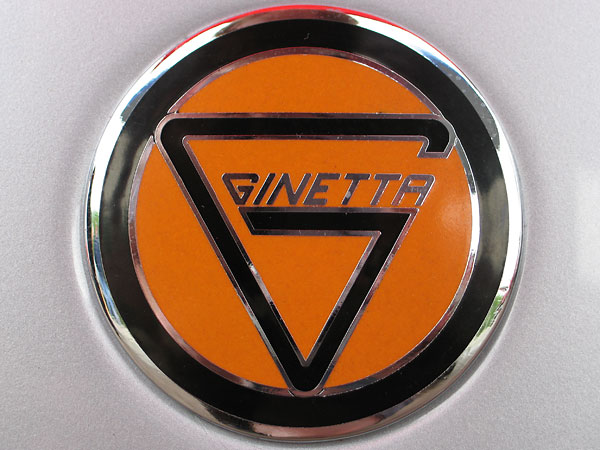
�
Ginetta Cars Ltd., West End Works, Witham, Essex, England.
�
Craig Chima's Ginetta G4: chassis number 173
��
Craig Chima purchased his Ginetta G4 after it had been garaged, disused, for about twenty years. �
The Ford Cortina GT (1500cc) engine didn't run, but there was no collision or rust damage to repair�
and the fiberglass bodywork was in very good shape. The car had only been street driven, and it had �
no racing history or modifications at all. Craig was excited to discover a car with so much potential. �
�
We feel very fortunate to have been able to see Craig's Ginetta on its very first outing.�
As would be expected on any shakedown weekend, some minor technical issues required attention. �
Nonetheless, the car comfortably lapped Virginia International Raceway in about two minutes �
eighteen seconds, for an average speed of 85mph over the circuit. Craig reported that he was �
seeing about 137mph before braking at the end of the long straightaway. Incidentally, Craig �
has also owned and raced Lotus and Caterham Sevens with similar drivetrains. He explained �
that the Ginetta's superior aerodynamics appear to give it a twelve to fifteen mile per hour �
advantage in top end.�
�
�
Enjoying this article? www.BritishRaceCar.com is partially funded through generous support from readers like you!
�
To contribute to our operating budget, please click here and follow the instructions.
�
(Suggested contribution is twenty bucks per year. Feel free to give more!)�
�
At V.I.R., Craig was paddocked directly across an alley from Kent and Jesse Prather of �
Prather Racing. One of the Prathers' customers, Bob Bramlage of Kansas, was there too�
racing his Pontiac Firebird. Apparently the Ginetta impressed Bob, because he decided �
to purchase Craig's Ginetta G4 and add it to his stable of vintage race cars. �
�
Craig tremendously enjoyed building this Series Two G4. He has a couple original Lotus �
Sevens in his garage to restore, but after that he'd like to return to another Ginetta G4 �
project. Given his choice, he'd like to tackle a Series Three next time because the box�
tube frames are a little bit stiffer and because in vintage racing the Series Three cars�
are permitted to run later and more powerful Ford Cortina crossflow or twin-cam engines.�
�
Features and Specifications
�| Engine: | �Ford Cortina (1498cc) engine, bored 0.040" over.�
Steel crankshaft (designed by Craig and made by Moldex.)�
CC Motorsports connecting rods.�
Midwest Motorsports (George Bauchman) custom ported cylinder head and custom designed camshaft. �
Titan roller rockers.�
Static compression ratio is ~14:1.�
Dual Weber 40DCOE carburetors with short velocity stacks.�
MSD Blaster 2 ignition coil.�
Accel Hi-Temp Super Stock Spiral Core 8mm spark plug wires.�
MSD6AL capacitive discharge ignition system.�
Titan cast aluminum dry sump oilpan.�
TDC Oil Pumps (from Fast Forward Components) 3-stage external oil pump.�
Patterson Enterprises dry sump oil reservoir.�
Laminova C43 Series water-cooled oil cooler. | �
| Cooling: | �AFCO Racing "Scirroco Style" dual-pass aluminum radiator. | �
| Exhaust: | �CC Motorsports four-into-one step-up headers. | �
| Transmission: | �Taylor Race Engineering's "TRE Inline" H-pattern 4-speed transmission. �
Custom bellhousing and annular clutch release bearing. | �
| Rear Axle: | �Morris Minor rear axle housing. �
Double bearing hubs and billet axle shafts.�
Tran-X limited slip differential. �
3.9:1 ring and pinion. | �
| Front Susp.: | �converted from rear-steer to front-steer configuration.�
standard Triumph Spitfire (Alford & Alder) forged uprights, switched right-for-left. �
Stock Ginetta lower A-arms. �
CC Motorsports fabricated upper A-arms with Heim joints on inboard ends to facilitate �
caster and camber adjustment. (Spherical bearings at the outer ends.)�
Spax adjustable coilover shock absorbers.�
Triumph Spitfire steering rack, strengthened and shortened and remounted to facilitate �
height adjustment to eliminate bump steer.�
CC Motorsports anti-sway bar. | �
| Rear Susp.: | �stock Ginetta lower A-link. Adjustable (Heim jointed) upper trailing links.�
Spax adjustable coilover shock absorbers. �
CC Motorsports adjustable anti-sway bar. | �
| Brakes: | �(master) dual Girling master cylinders with bias bar. � (front) stock Girling calipers and nine inch solid rotors. � (rear) stock BMC 8" drum brakes. | �
| Wheels/Tires: | �Kodiak FX 13x5.5 three-piece modular aluminum wheels (forged centers). Avon ACB10 Sport 7.0/21.0/13 tires. | �
| Instruments: | �(left to right)�
AEM UEGO digital air/fuel mixture gauge, �
VDO coolant temperature gauge (100-250F, black bezel),�
VDO oil temperature gauge (100-250F, chrome bezel),�
VDO oil pressure gauge (0-100psi), �
Stack tachometer (0-10400rpm). | �
| Electrical: | �Tilton Super Starter.�
EverStart lead/acid lawn tractor battery.�
(No charging system.) | �
| Fuel System: | �Fuel Safe 8-gallon fuel cell.�
Facet electric (cube type) fuel pump.�
Holley fuel pressure regulator. �
Mr Gasket fuel pressure gauge (0-15psi).�
JEGS in-line billet fuel filter. | �
| Safety Eqmt: | �G-Force safety harness.�
FireBottle fire suppression system. | �
| Weight: | �~1075 pounds.�
Approximately 50/50 weight distribution. | �
| Racing Class: | �8CP | �
Engine Installation
��
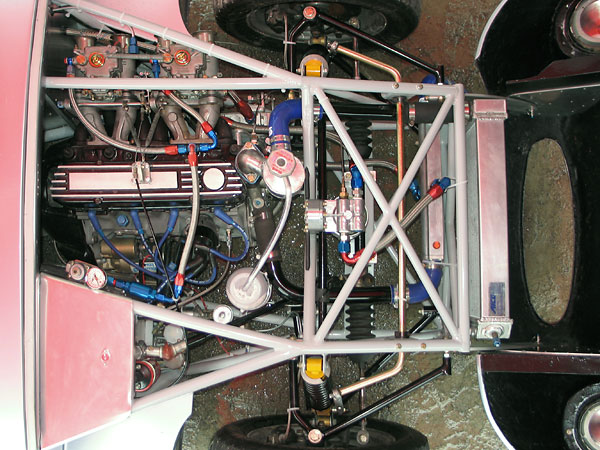
�
Ford Cortina (1498cc) engine, bored 0.040" over.
�
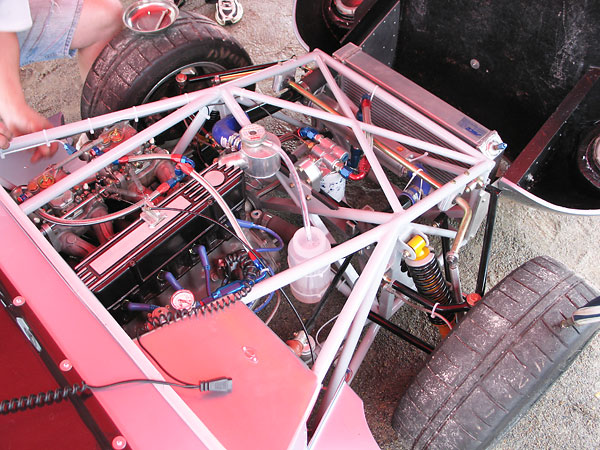
�
Craig Chima works closely with his friend George Bauchman of Midwest Motorsports to build highly
�
tuned race engines. George ported this cylinder head and paired it with a custom camshaft profile.
�
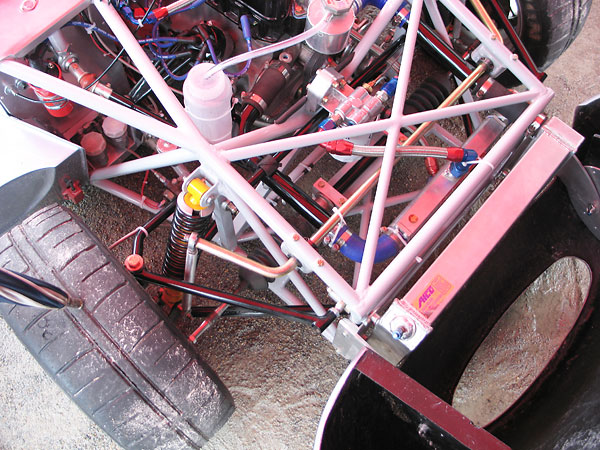
�
Afco "Scirroco Style" dual-pass aluminum radiator and Laminova C43 Series water-cooled oil cooler.
�
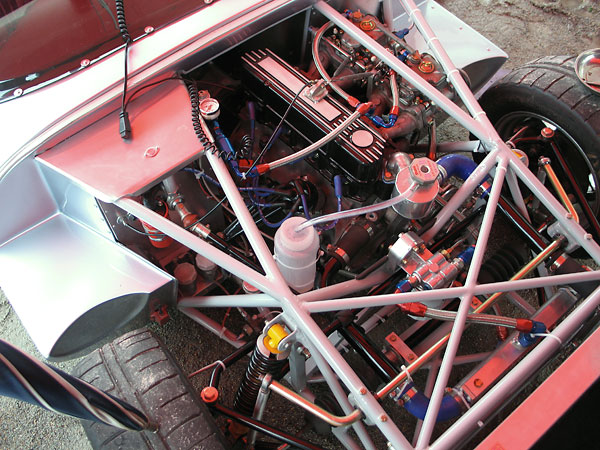
�
Series One and Two Ginetta G4 cars featured spaceframes constructed of 1" x 18-gauge round steel tubing.
�
This particular chassis has been restored and extensively strengthened by Craig Chima of CC Motorsports.
�
No tubes were removed from the original spaceframe chassis, but more than a few were added.
�
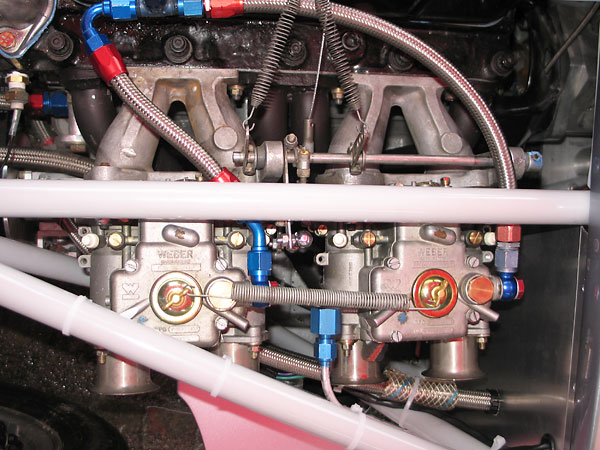
�
Directly above what appear to be Derrington intake manifolds, we see one of the newly added tubes.
�
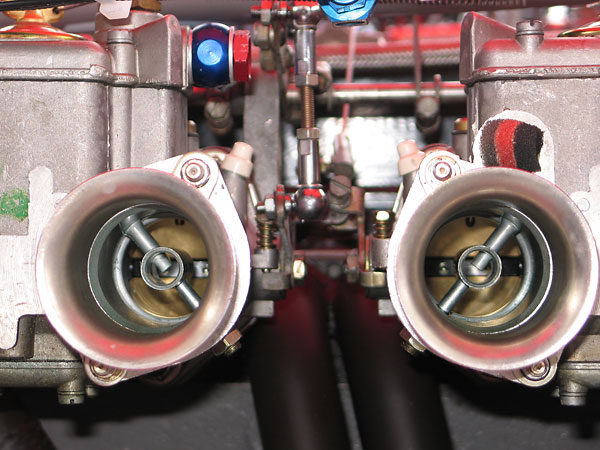
�
Dual Weber 40DCOE carburetors with short velocity stacks.
�
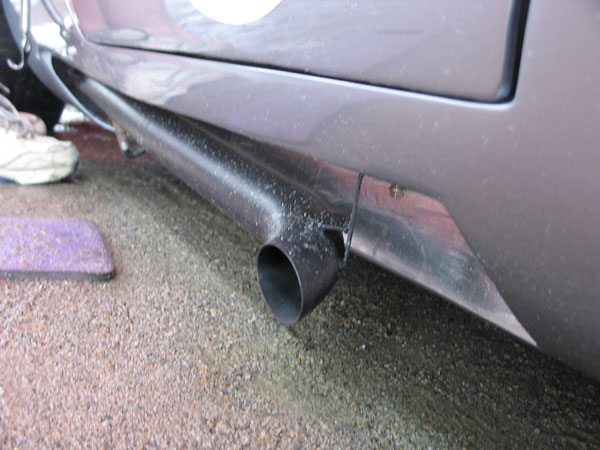
�
The 4-into-1 header tubes step-up in diameter three times before the collector, based on
�
exhaustive development and testing. Details are a trade secret of CC Motorsports.
�
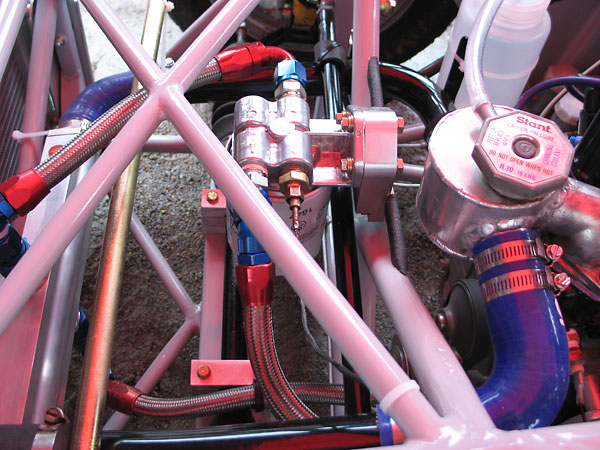
�
Both above and below the remote oil filter, we see X-bracing where the original Ginetta G4 design only had
�
single diagonals. The steering rack has been relocated from its original location, to convert the car from
�
rear-steering to front-steering, which made more room for the engine's harmonic balancer and for
�
accessory pulleys. The removeable cross brace just behind the oil filter is also a new addition.
�
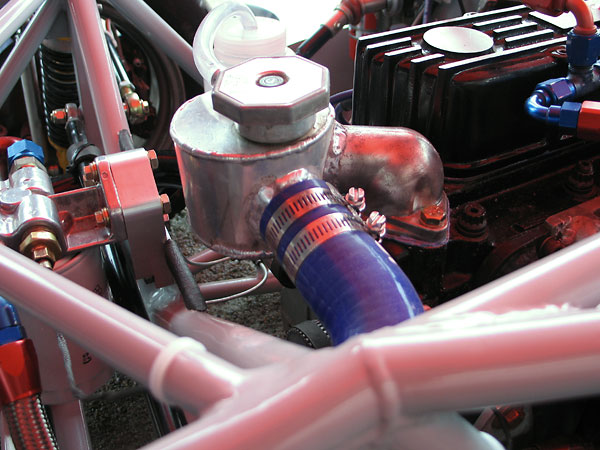
�
Custom fabricated coolant filler.
�
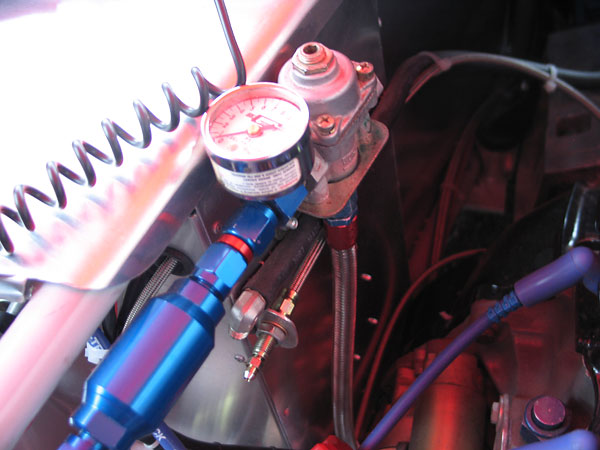
�
Holley fuel pressure regulator. Mr Gasket fuel pressure gauge (0-15psi). JEGS in-line filter.
�
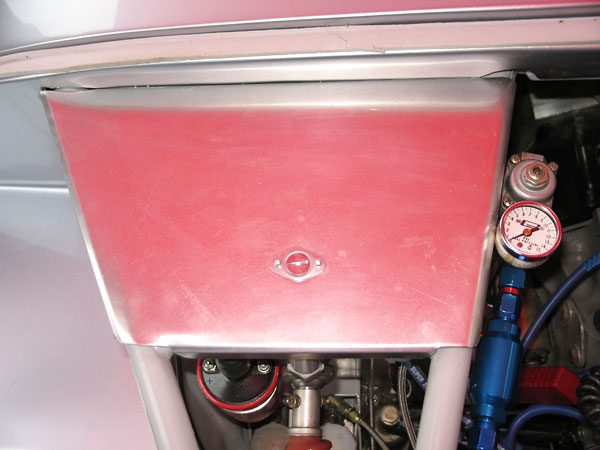
�
This top-of-the-footbox access panel (for pedal adjustment, etc.) is a new feature.
�
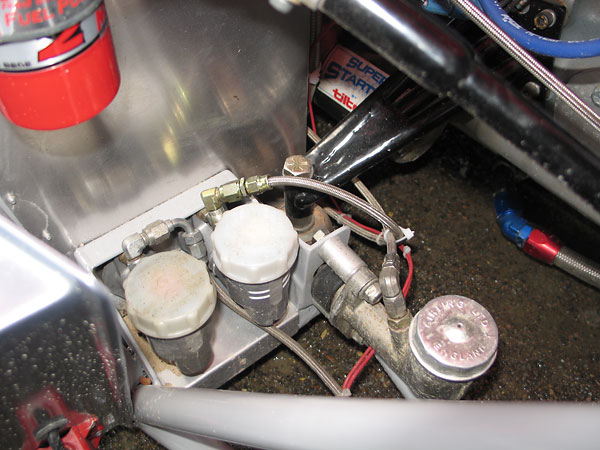
�
Dual Girling brake master cylinders with bias bar.
�
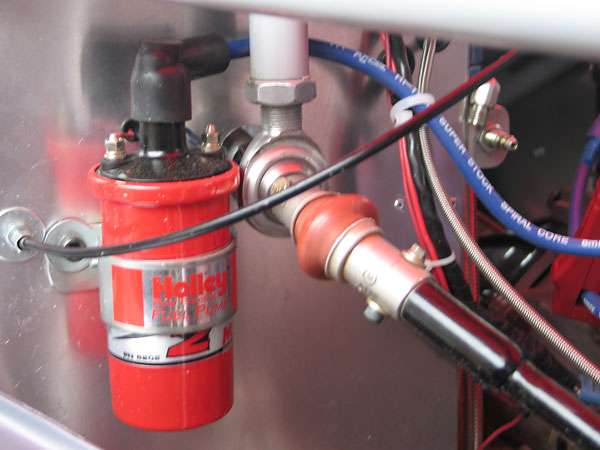
�
MSD Blaster 2 ignition coil. Note also: a new steering column was required to suit the new
�
steering rack location. Craig decided to make it easily adjustable as partly shown here.
�
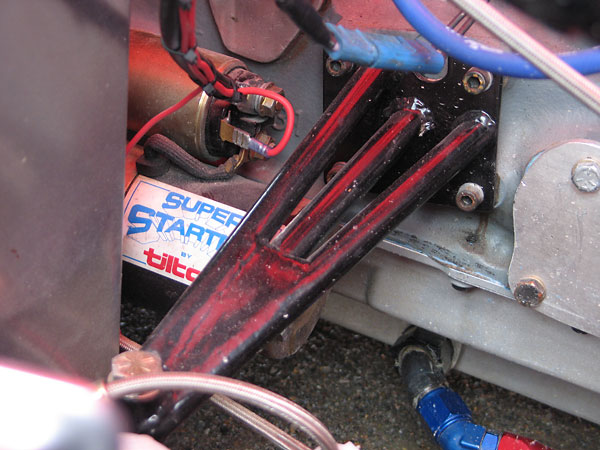
�
Super Starter by Tilton. Titan cast aluminum dry sump oilpan.
�
(CC Motorsports is an authorized distributor for Titan.)
�
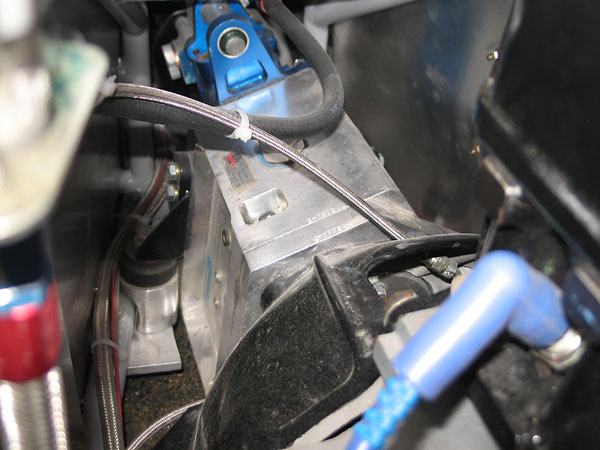
�
Taylor Race Engineering 4-speed transmission, mounted on a custom-modified Ford bellhousing, utilizing
�
a custom annular clutch release bearing. The Taylor Inline transmission is a dog-ring box with Hewland
�
or Webster gears. All four gears can be changed in under an hour to get any desired combination of gear
�
ratios. Over a hundred gear ratios are available. The transmission weighs only approximately 45 pounds.
�
 �
�
�
�
Suspension
��
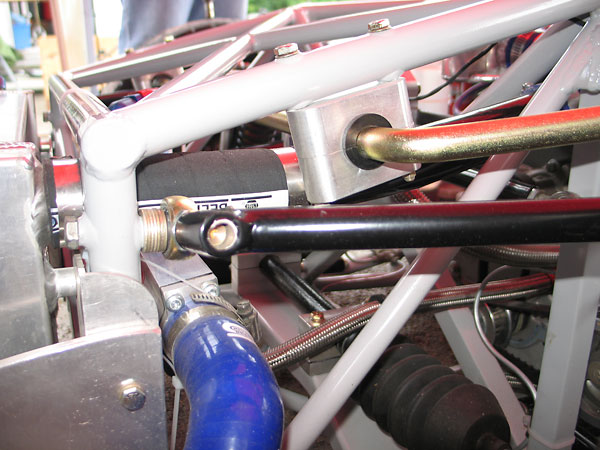
�
The narrowed Triumph Spitfire steering rack is mounted on a very robustly braced structure.
�
Its mounting height is easily adjustable to eliminate bump steer.
�
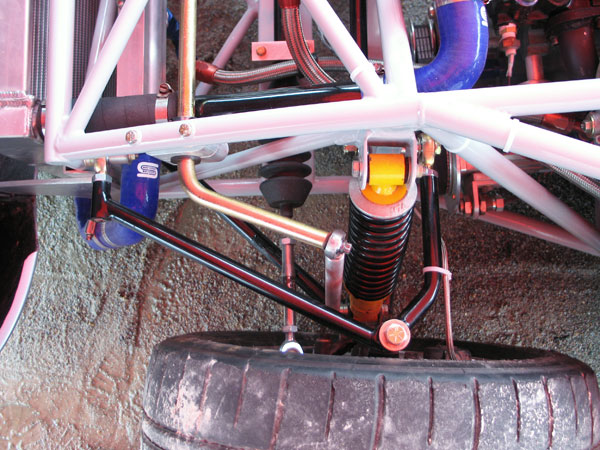
�
CC Motorsports fabricated upper A-arms have Heim joints to facilitate caster and camber adjustment.
�
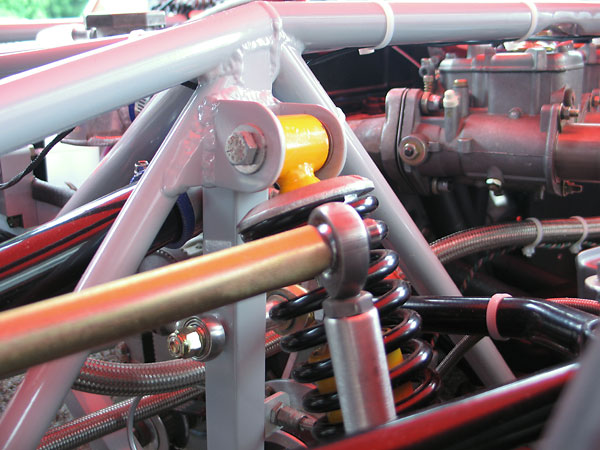
�
Front and rear anti-sway bars were custom designed and made by CC Motorsports. The necessary stiffness
�
of the bars was estimated with a computer model that considered corner weights, wheel rates, etc. The
�
front bar's stiffness is about 400 pounds per inch. The rear bar is adjustable from around 100 to 175lb/in.
�
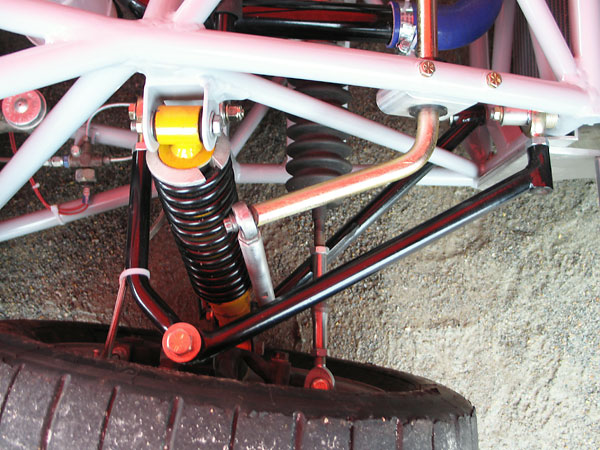
�
Spax adjustable coilover shock absorbers are installed front and rear.
�
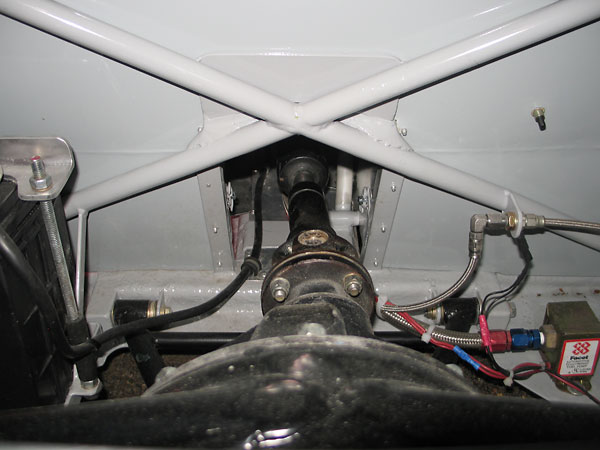
�
The bottom of the pumpkin is connected to the chassis by an A-shaped link that locates it both
�
laterally and longitudinally, and also defines the rear suspension's roll center.
�
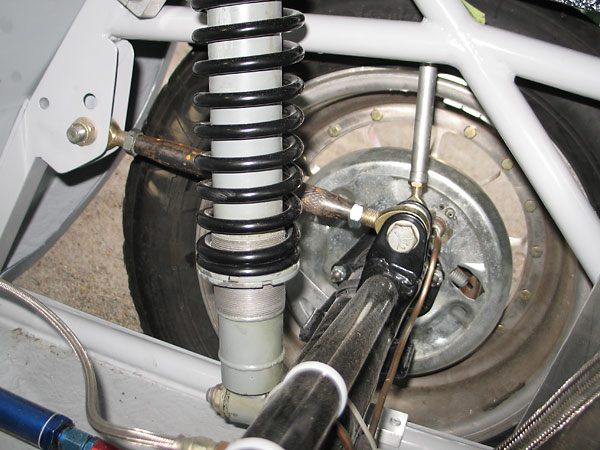
�
Adjustable length upper radius rods and a choice of two forward mounting points on the chassis bracket
�
facilitate precise alignment of the rear axle and also accomodate dialing-in a little anti-squat.
�
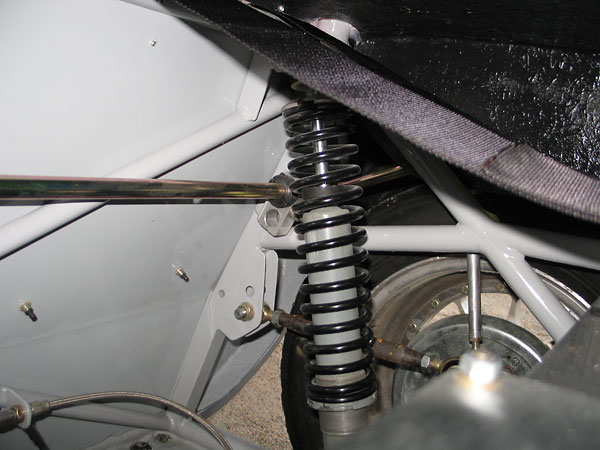
�
Ideally suspension brackets should be located at joints in the spaceframe, and aligned so the forces they
�
apply translate into pure tension or compression loads in frame tubes. In that situation, round tubes are
�
most efficient in terms of strength to weight ratio. When designers have to compromise and feed loads
�
into a frame member along its span, that member is subjected to a buckling force. Weight for weight,
�
box tubing is better than round for resisting buckling. Ginetta certainly had these suspension links
�
attached at mid-span, although the original brackets have been replaced. The almost horizontal
�
braces you see behind the shock absorbers, here and in the next photo, were added by Craig.
�
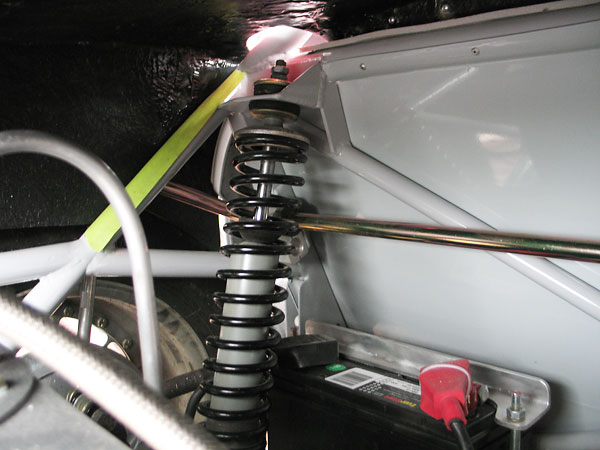
�
The rear anti-sway bar's stiffness is adjusted by sliding the attachment of the connecting link,
�
but that's hidden from view in these photos because the bar extends into the wheel wells.
�
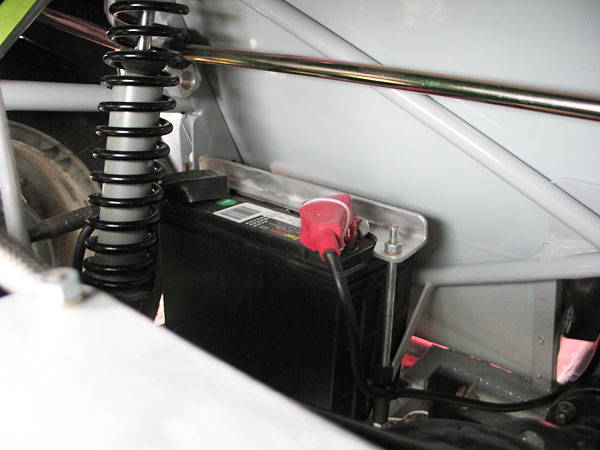
�
EverStart lead/acid lawn tractor battery. The car has no charging system, so the battery must have
�
sufficient capacity to power the ignition thoughout each race. Then, it's recharged in the paddock.
�
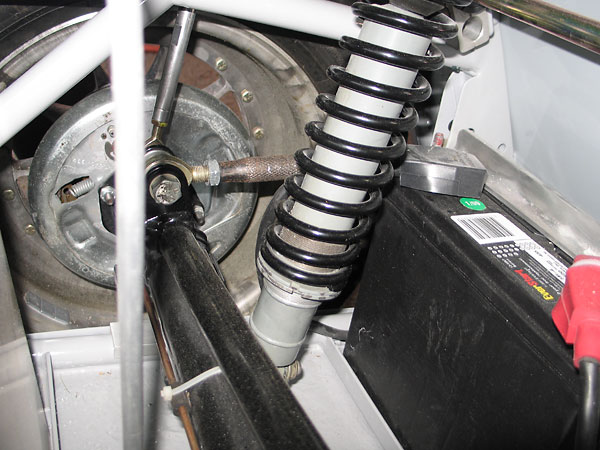
�
Morris Minor rear axle housing with double bearing hubs and billet axle shafts. Stock BMC 8" drum brakes.
�
�
Interior
��
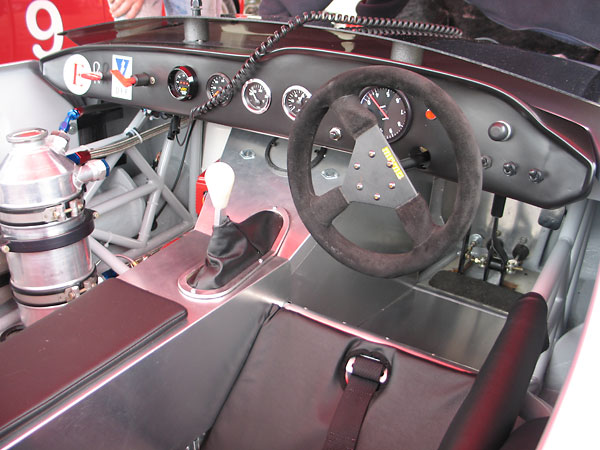
�
(left to right) AEM UEGO digital air/fuel mixture gauge, VDO coolant temperature gauge (100-250F),
�
VDO oil temp gauge (100-250F), VDO oil pressure gauge (0-100psi), and Stack tachometer (0-10400rpm).
�
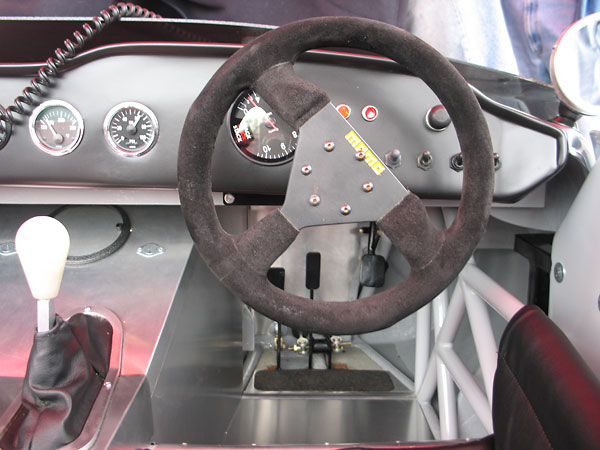
�
Momo steering wheel. Note: the entire steering assembly is adjustable for position and length.
�
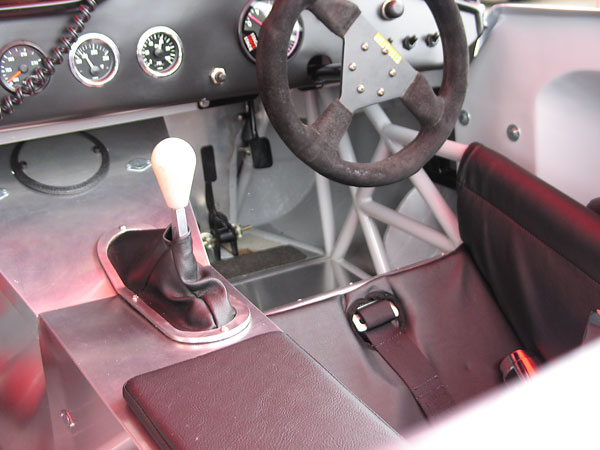
�
Rather than have a driver's seat per se, the Ginetta G4 has padding that covers aluminum panels.
�
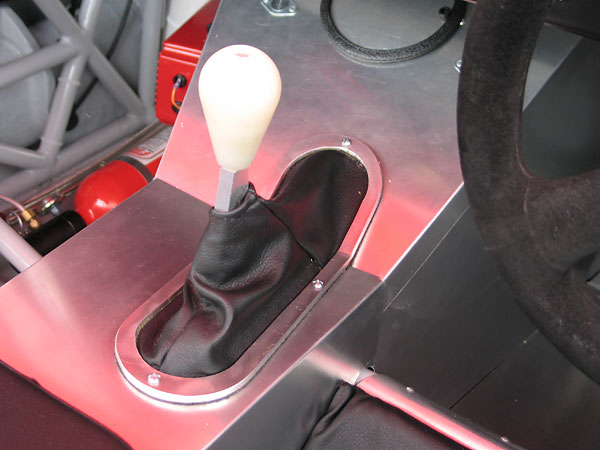
�
The TRE "Inline" transmission has an H-pattern gear selector. A sequential shifter is under development.
�
The transmission is available in both four and five speed versions.
�
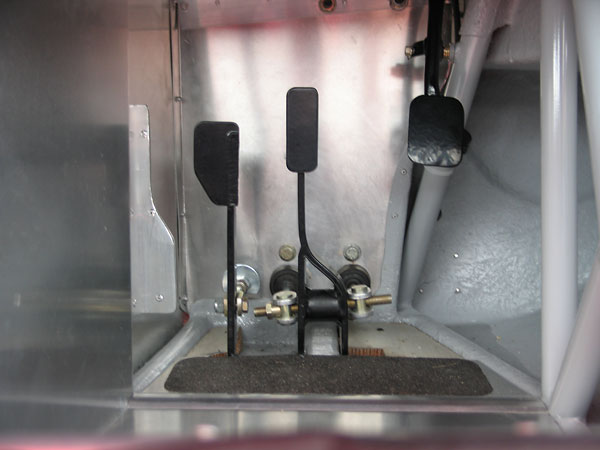
�
Lightweight pedals make the most of a narrow footbox.
�
�
�
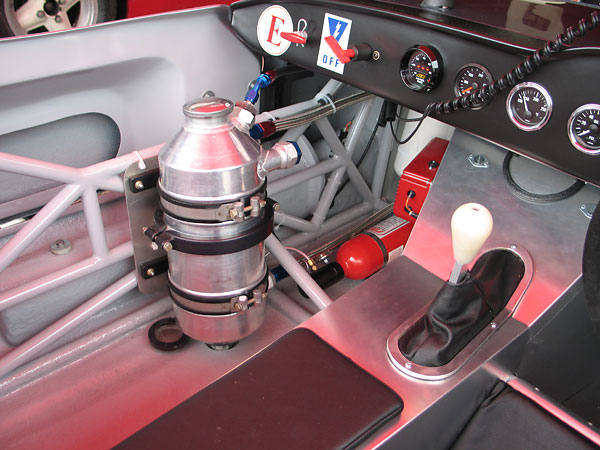
�
Patterson Enterprises dry sump oil reservoir.
�
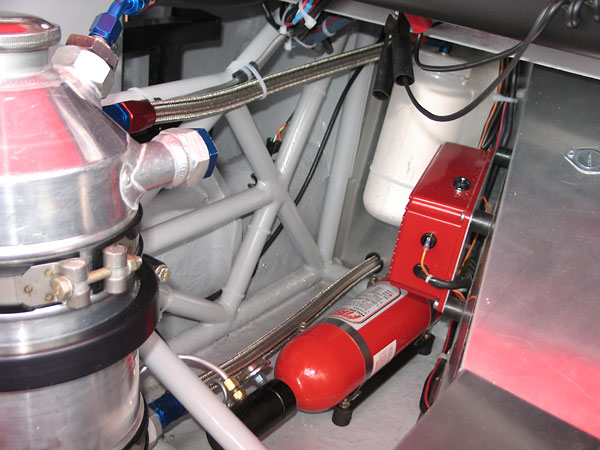
�
FireBottle centralized fire suppression system.
�
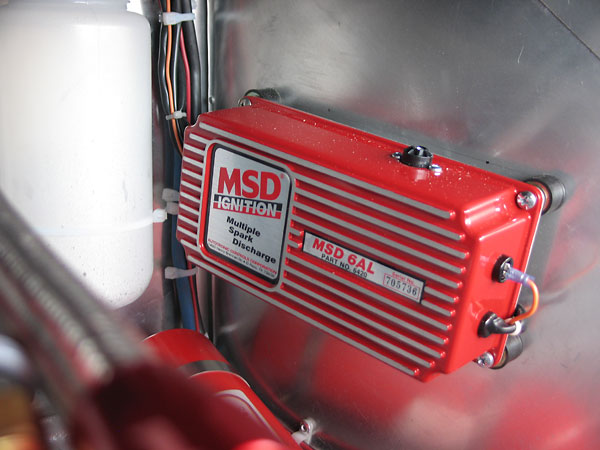
�
MSD6AL capacitive discharge ignition system.
�
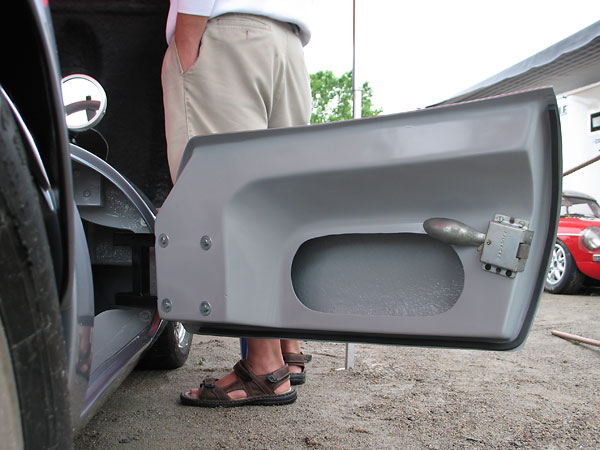
�
When contemporary magazines reviewed the Ginetta G4, they seemed particularly impressed by the doors.
�
They close securely and they don't rattle.
�
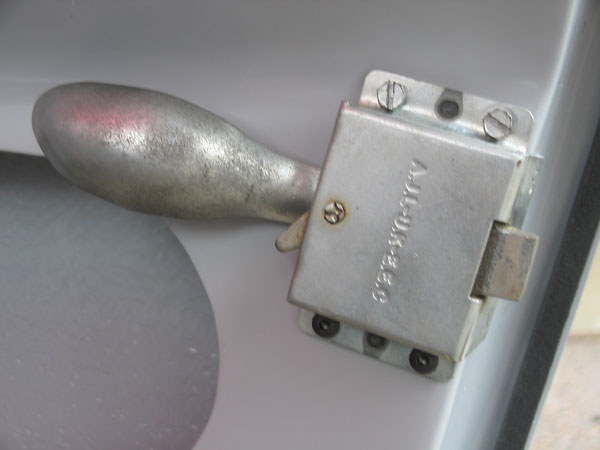
�
Land Rover "pudding spoon" door latches are only operable from inside of the car.
�
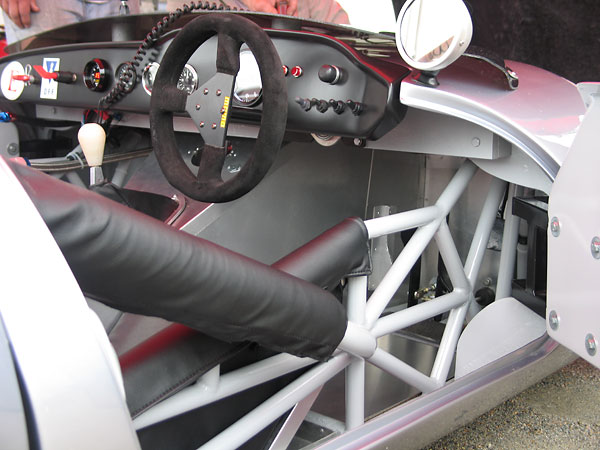
�
It's normal to see exposed chassis tubes when you open the door of a Ginetta G4. However,
�
this car has rather more than usual. All tubes above waist level in this view are new.
�
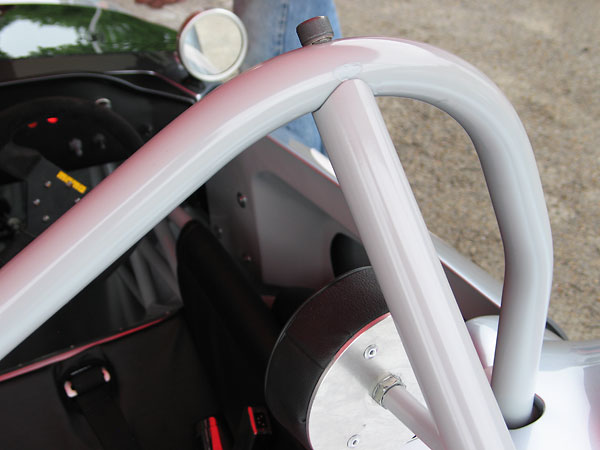
�
The rearward roll hoop brace is detachable so that the whole rear body section can be removed.
�
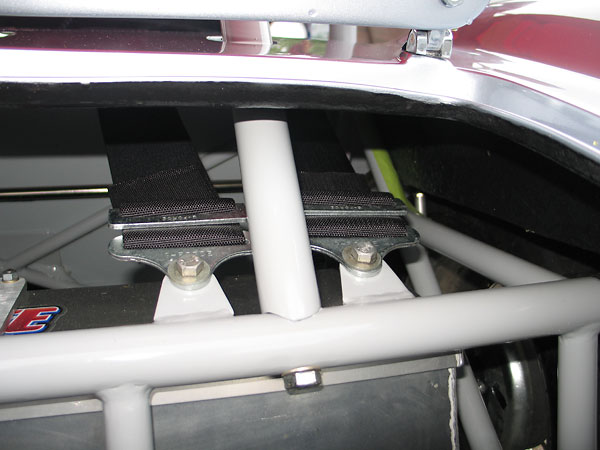
�
Shoulder harness attachment.
�
�
Exterior
��
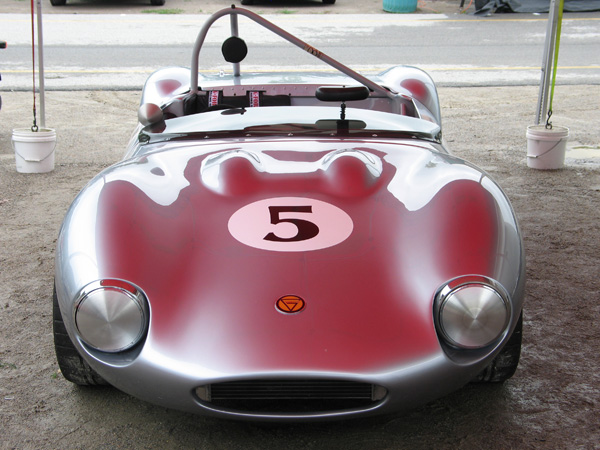
�
The Walklett brothers summed up their approach in an early press statement: "For a small manufacturer
�
to keep alive he must have a product which doesn't compete with the big boys, is attractive to look
�
at and drive, and, above all, is competitively priced." (as quoted in MotorSport magazine, April 1964.)
�
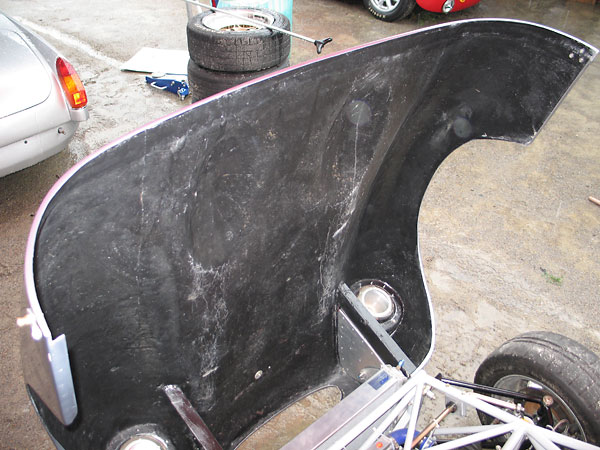
�
The Ginetta G4 fiberglass bonnet pivots forward for excellent access to the engine.
�
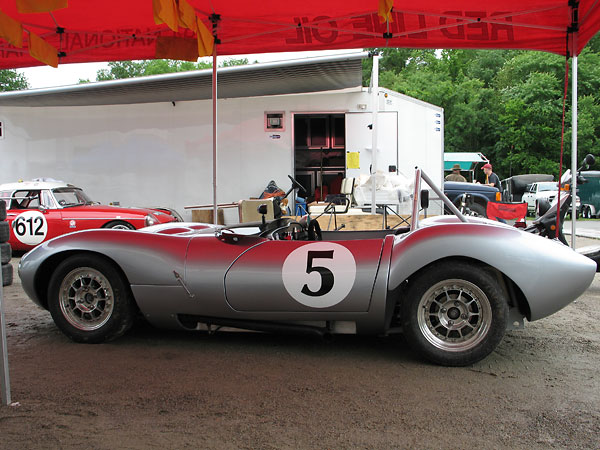
�
This is a Series Two Ginetta G4. It has a 6' 8" wheelbase and an 11' 8" overall length. (The Series One G4
�
looks similar except it has small tail fins and is eight inches shorter in the tail section.)
�
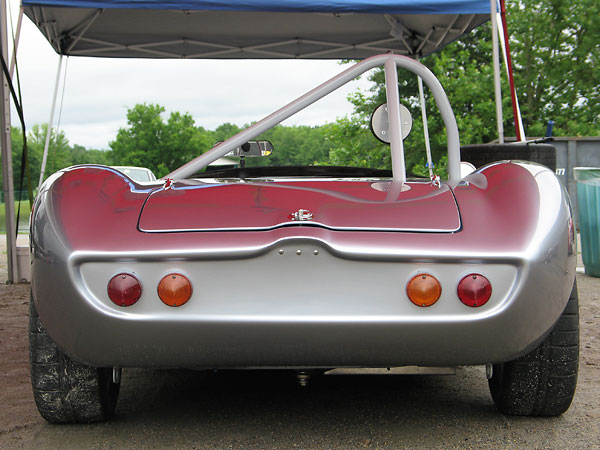
�
Ginetta G4, viewed from the rear. (3' 11.5" track, 4' 8" overall width.)
�
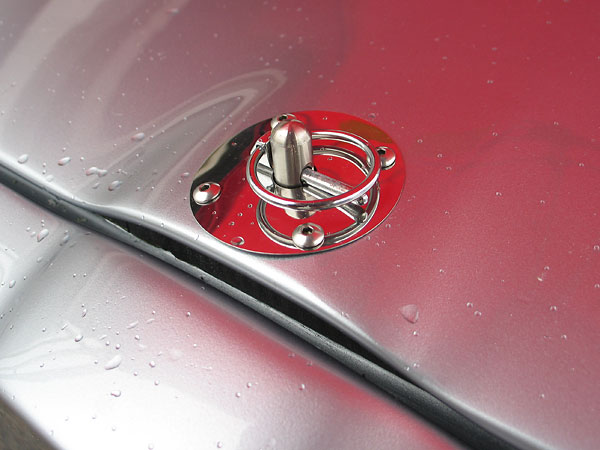
�
A pin restrains the boot lid on this race car. A keyed lock was usually installed on street-driven cars.
�
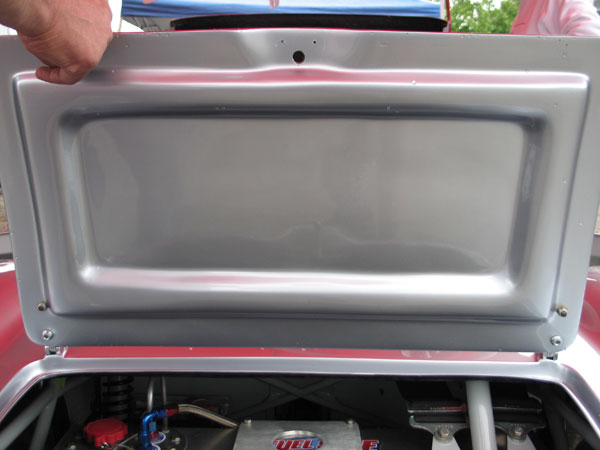
�
The boot lid opens neatly, plus the whole rear section of the body is easily removeable for chassis access.
�
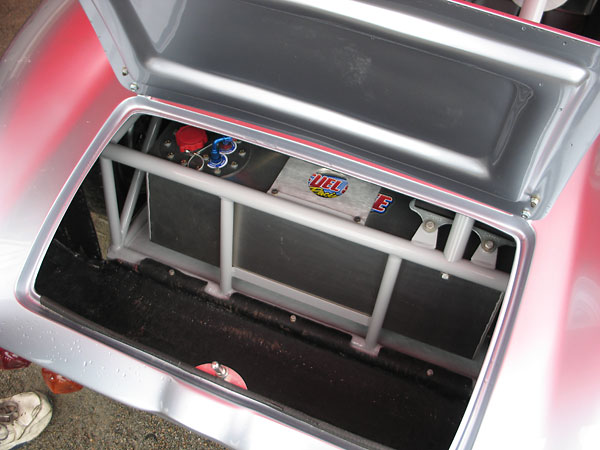
�
This Fuel Safe 8-gallon fuel cell. (This cell is the same size commonly used on Lotus Seven racecars.)
�
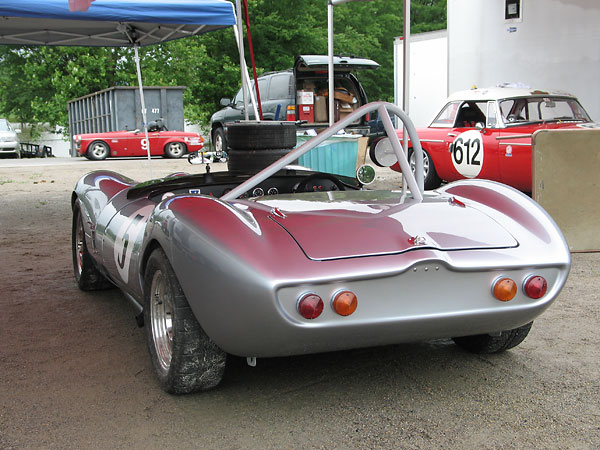
�
At the 2009 Heacock Classic Gold Cup's SVRA Group 8 feature race, we watched this Ginetta lap
�
V.I.R. in 2:18.107, for an average speed of 85.24mph over the 3.27 mile circuit. That's a great
�
debut for a newly restored car. The course workers voted Craig winner of the Optima Battery Award.
�
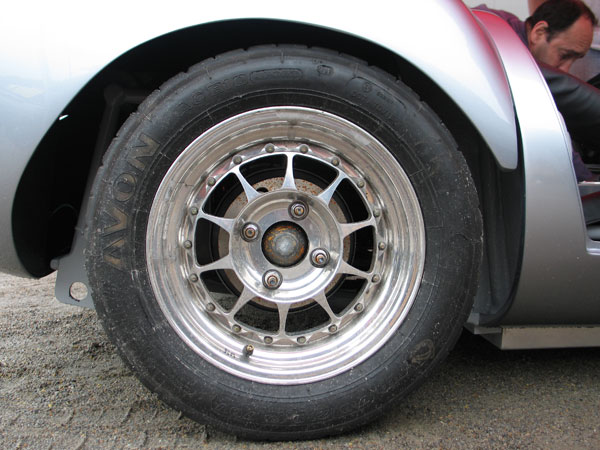
�
Kodiak FX 13x5.5 three-piece modular aluminum wheels (forged centers). Avon ACB10 Sport 7.0/21.0/13 tires.
�
�
All photos shown here are from June 2009, when we viewed the car at The Heacock Classic Gold Cup at �
Virginia International Raceway. All photos by Curtis Jacobson for BritishRaceCar.com, copyright 2010. �
All rights reserved.
�
| If you liked this article, you'll probably also enjoy these: | �|||||
 | �
Andy Seward '62 Marcos GT | �
 | �
Vic Schuster '65 Turner MkIII | �
 | �
Derek Chima '66 MG Midget | �
| You're invited to discuss anything you've seen here on The British Racecar Motorsports Forum! | �|||||
�
Notice: all the articles and almost all the photos on BritishRacecar.com are by Curtis Jacobson.
�
(Photos that aren't by Curtis are explicitly credited.) Reproduction without prior written permission is prohibited.
�
Contact us to purchase images or reproduction permission. Higher resolution images are optionally available.
�

 �
�